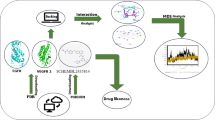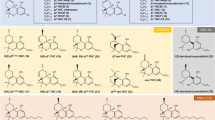Abstract
Bradykinin (BK) and its analogs (1 nM-100 μM) stimulated phosphoinositide (PI) turnover in murine fibrosarcoma (HSDM1C1) cells in a concentration-dependent manner. The relative potencies (EC50) were: BK=48±4 nM; Lys-BK=39±3 nM; Met-Lys-BK=158±33 nM; Des-Arg9-BK=2617±598 nM (means±SEM, n=3–14). All these analogs were full agonists and they produced up to 5.4±0.4-fold stimulation of PI turnover at the highest concentration (10–100 μM) of the peptides. In contrast, the analogs [D-Arg0-HYP3-Thienyl5,8-D-Phe7]-BK (HYP3-antagonist), [D-Arg0-HYP3-Thienyl,5,8-D-Phe7]-BK (Thienyl antagonist) and Des-Arg9-Leu8-BK were inactive, as agonists, at 0.1 nM-1 μM in this system. These data suggested that BK-induced PI turnover in these cells was mediated via B2-type of BK receptors. This was confirmed further by the fact that both the B2-selective Hyp3- and Thienyl-antagonists inhibited BK-induced PI turnover with KBS of 369±51 nM and 368±118 nM respectively while the B1-selective antagonist, Des-Arg9-Leu8-BK, was inactive at 1 μM. [3H]BK receptor binding studies revealed two binding sites, one with high affinity (Kd=0.24±0.06 nM; Bmax=1.4±0.4 pmol/g tissue) and the other with low affinity (Kd=18.5±0.95 nM; Bmax=25.1±0.52 pmol/g tissue), on HSDM1C1 cell homogenates. The rank order of affinity of BK analogs at inhibiting specific [3H]BK binding was similar to that found for PI turnover. Taken together, these data have provided evidence for the presence of two B2-type BK binding sites on the HSDM1C1 cells. Based on the affinity parameters, the low-affinity component of [3H]BK binding in HSDM1C1 cells appears to be coupled to the phospholipase C-induced PI turnover mechanism. The high-affinity component has been previously shown to mediate the production of prostaglandins by activation of phospholipase A2.
Similar content being viewed by others
References
Regoli, D., and Barabe, J. 1980. Pharmacology of bradykinin and related kinins. Pharmacol. Rev. 32:1–46.
Regoli, D., Rhaleb, N-E, Dion, S., and Drapeu, G. 1990. New selective bradykinin receptor antagonists and bradykinin B2 receptor characterization. Trends Pharmac. Sci. 11:156–161.
Regoli, D., Drapeau, G., Rovero, P., Dion, S., D'Orelans-Juste, P., and Barabe, J. 1986. The actions of kinin antagonists on B1 and B2 receptor systems. Eur. J. Pharmacol. 123:61–65.
Perry, D. C., and Snyder, S. H. 1984. Identification of bradykinin in mammalian brain. J. Neurochem. 43:1072–1080.
Dray, A., Bettaney, J., Forster, P., and Perkins, M. N. 1988. Activation of a bradykinin receptor in peripheral nerve and spinal cord in the neonatal rat in vitro. Br. J. Pharmacol. 95:1008–1010.
Baccaglini, P. I., and Hogan, P. G. 1983. Some rat sensory neurons in culture express characteristics of differentiated pain sensory cells. Proc. Natl. Acad. Sci. USA 80:594–598.
Miller, R. J. 1987. Bradykinin highlights the role of phospholipid metabolism in the control of nerve excitability. Trends Neurosci. 10:226–228.
Manning, D. C., Snyder, S. H., Kachur, J. F., Miller, R. J., and Field, M. 1982. Bradykinin receptor-mediated chloride secretion in intestinal function. Nature. 299:256–259.
Nasjletti, A., and Malik, K. U. 1981. The renal kallikrein-kinin and prostaglandin systems interaction. Ann. Rev. Physiol. 43:597–609.
Manning, D. C., Vavrek, R., Stewart, J. M., and Snyder, S.H. 1986. Two bradykinin binding sites with picomolar affinities. J. Pharmacol. Exp. Ther. 237:504–512.
Sharif, N. A., and Whiting, R. L. 1991. Identification of B2-bradykinin receptors in guinea pig brain regions, spinal cord and peripheral tissues. Neurochem. Int. 18:89–96.
Braas, K. M., Manning, D. C., Perry, D. C., and Snyder, S. H. 1988. Bradykinin analogues: Differential agonist and antagonist activities suggesting multiple receptors. Br. J. Pharmacol. 94:35.
Steranka, L. R., Manning, D. C., DeHaas, C. J., Ferkany, J. W., Borosky, Connor, J. R., Vavrek, R. J., Stewart, J. M., and Snyder, S. H. 1988. Bradykinin as a pain mediator: Receptors are localized to sensory neurons, and antagonists have analgesic actions. Proc. Natl. Acad. Sci. USA, 85:3245–3249.
Dray, A., Bettaney, J., Forster, P. and Perkins, M. N. 1988. Bradykinin-induced stimulation of afferent fibers is mediated through protein kinase C. Neurosci. Lett. 91:301–307.
Vavrek, R. J., and Stewart, J. M. 1985. Competitive antagonists of bradykinin. Peptides, 6:161–164.
Farmer, S. G., Burch, R. M., Meeker, S. A., and Wilkins, D. E. 1989. Evidence for a pulmonary B3 bradykinin receptor. Mol. Pharmacol. 36:1–8.
Yano, K., Higashida, H., Inoue, R., and Nozawa, Y. 1984. Bradykinin-induced rapid breakdown of phosphatidyl 4,5-bisphosphate in neuroblastoma×glioma hybrid NG108-15 cells. J. Biol. Chem. 259:10201–10207.
Francel, P. C., Miller, R. J., and Dawson, G. 1987. Modulation of bradykinin-induced inositol trisphosphate release in a novel neuroblastoma×dorsal root ganglion sensory neuron cell line. J. Neurochem. 48:1632–1639.
Sharif, N. A., Hunter, J. C., Hill, R. G., and Hughes, J. 1988. Bradykinin-induced accumulation of [3H]inositol-1-phosphate in human embryonic pituitary tumour cells by activation of a B2-receptor. Neurosci. Lett. 86:279–283.
Burgess, G. M., Mullaney, I., McNeill, M., Dunn, P. M., and Rang, H. P. 1989. Second messengers involved in the mechanism of action of bradykinin in sensory neurons in culture. J. Neurosci. 9:3314–3325.
Ranson, J. T., Dunne, J. F., and Sharif, N. A. 1993. Flow cytometric selection of responsive subclones and fluorometric analysis of intracellular Ca2+-mobilization. in “Molecular Imaging in Neuroscience: A Practical Approach” (N. A. Sharif, Ed.), Oxford University Press (in Press).
Ransom, J. T., Cherwinski, H. M., Dunne, J. F., and Sharif, N. A. 1991. Flow cytometric analysis of internal calcium mobilization via a B2-bradykinin receptor on a subclone of PC-12 cells. J. Neurochem. 56:983–989.
Francel, P. C., Harris, K., Smith, M., Fishman, M. C., Dawson, G., and Miller, R. J. 1987. Neurochemical characteristics of a novel dorsal root ganglion X neuroblastoma hybrid cell line, F 11. J. Neurochem. 48:1624–1631.
Francel, P. C., Keefer, J. F., and Dawson, G. 1989. Bradykinin analogs antagonize bradykinin-induced second messenger production in a sensory neuron cell line. Mol. Pharmacol. 35:34–38.
Snider, R. M., and Richelson, E. 1984. Bradykinin receptormediated cyclic GMP formation in a nerve cell population (murine neuroblastoma clone N1E-115). J. Neurochem., 43:1749–1754.
Johns, A., Lategan, T. W., Lodge, N. J., Ryan, U. S., van Breemen, C., and Adams, D. J. 1987. Calcium entry through receptor-operated channels in bovine pulmonary artery endothelial cells. Tissue & Cell, 19:1–13.
Becherer, P. R., Mertz, L. F., and Baenziger, N. L. 1982. Regulation of prostaglandin synthesis mediated by thrombin and B2 bradykinin receptors in a fibrosarcoma cell line. Cell 30:243–251.
McIntyre, T. M., Zimmerman, G. A., Satoh, K., and Prescott, S. M. 1985. Cultured endothelial cells synthesize both plateletactivating factor and prostacyclin in response to histamine, bradykinin and adenosine triphosphate. J. Clin. Invest. 76:271–280.
Ryan, U. S., Johns, A., and Van Breemen, C. 1988. Role of calcium in receptor mediated endothelial cell responses. Chest. 93:105S-109S.
Berridge, M. J., and Irvine, R. F. 1984. Inositol trisphosphate, a novel second messenger in cellular signal transduction. Nature (London) 312:315–321.
Hawthorne, J. N. 1987. Does receptor-linked phosphoinositide metabolism provide messengers mobilizing calcium in nervous tissue? Int. Rev. Neurobiol. 28:241–273.
Conklin, B. R., Burch, R. M., Steranka, L. R., and Axelrod, J. 1988. Distinct bradykinin receptors mediate stimulation of prostaglandin synthesis by endothelial cells and fibroblasts. J. Pharm. Exp. Ther. 244:646–649.
Sharif, N. A., Michel, A. D., and Whiting, R. L. 1989. Bradykinin receptor binding to membranes and whole cells of a fibrosarcoma cell-line (HSDM1C1). FASEB J., 3, Abst. #2893.
Sharif, N. A., and Whiting, R. L. 1990. Stimulation of inositol phosphate production in clonal HSDM1C1 cells by endothelins and sarafotoxin. Biochem. Pharmacol. 40:1928–1931.
Berridge, M. J., Downes, C. P., and Hanley, M. R. 1982. Lithium amplifies agonist-dependent phosphatidylinositol responses in brain and salivary gland. Biochem. J., 206:587–595.
Michel, A. D., and Whiting, R. L. 1984. Analysis of ligand binding data using a microcomputer. Brit. J. Pharmacol. 83:460P.
Arunlakshana, O., and Schild, H. O. 1959. Some quantitative uses of drug antagonists. Brit J. Pharmacol. Chemother. 14:48–58.
Brown, E., Kendall, D. A., and Nahorski, S. R. 1984. Inositol phospholipid hydrolysis in rat cerebral cortex slices: 1. Receptor characterisation. J. Neurochem. 42:1379–1387.
Innis, R. B., Manning, D. C., Stewart, J. M. and Snyder, S. H. 1981. [3H]Bradykinin receptor binding in mammalian tissue membranes. Proc. Natl. Acad. Sci. USA 78:2630–2635.
Lewis, R. E., Childers, S. R., and Phillips, M. I. 1985. [125]Tyrbradykinin binding in primary rat brain cultures. Brain Res. 346:263–272.
Munson, P. J., and Rodbard, D. 1980. LIGAND: A versatile computerised approach for the characterization of ligand binding systems. Anal. Biochem. 107:220–239.
Rifo, J., Pourrat, M., Vavrek, R. J., Stewart, J. M., and Huidobro-Toro, J. P. 1987. Bradykinin receptor antagonists used to characterize the heterogeneity of bradykinin-induced responses in rat vas deferens. Eur. Pharmacol. 142:305–312.
Schachter, M., Uchida, Y., Longridge, D. J., Labedz, T., Whalley, E. T., Vavrek, R. J., and Stewart, J. M. 1987. New synthetic antagonists of bradykinin. Br. J. Pharmacol. 92:851–855.
Whalley, E. T., Nwator, I. A. A., Stewart, J. M., and Vavrek, R. J. 1987. Analysis of the receptors mediating vascular actions of bradykinin. Naunyn Schmiedebergs Arch. Pharmacol., 336:430–433.
Plevin, R., and Owen, P. J. 1988. Multiple B2 kinin receptors in mammalian tisses. Trends Pharmac. Sci. 9:287–289.
Ransom, R. W., Goodman, C. B., and Young, G. S. 1992. Bradykinin stimulation of phosphoinositide hydrolysis in guinea pig ileum longitudinal muscle. Brit. J. Pharmacol. 105:919–924.
Voyno-Yasemetskaya, T. A., Tkachuk, V. A., Cheknyova, E. G., Panchenko, M. P., Grigorian, G. Y., Vavrek, R. J., Stewart, J. M., and Ryan, U. S. 1989. Guanine nucleotide-dependent, pertussis toxi-insensitive regulation of phosphoinositide turnover by bradykinin in bovine pulmonary artery endothelial cells. FASE J. 3:44–51.
Cholewinski, A. J., Hanley, M. R., and Wilkin, G. P. 1988. A phosphoinositide linked peptide response in astrocytes: Evidence for regional heterogeneity. Neurochem. Res. 13:389–394.
Sung, C-P., Arleth, A. J., Shikano, K., and Berkowitz, B. A. 1988. Characterization and function of bradykinin receptors in vascular endothelial cells. J. Pharm. Exp. Ther. 247:8–13.
Chuang, D., and Dillon-Carter, O. 1988. Characterization of bradykinin induced phosphoinositide turnover in neurohybrid NCB-20 cells. J. Neurochem. 51:505–513.
Fu, T., Okano, Y., and Nazawa, Y. 1988. Bradykinin-induced generation of inositol 1,4,5-trisphosphate in fibroblasts and neuroblastoma cells: Effect of pertussis toxin, extracellular calcium, and down-regulation of protein kinase C. Biochem. Biophys. Res. Comm. 157:1429–1435.
Downward, J., De Gunzburg, J., Riehl, R., and Weinberg, R. 1988. p21ras induced responsiveness of phosphatidylinositol turnover to bradykinin is a receptor number effect. Proc. Natl. Acad. Sci. USA, 85:5774–5778.
Fisher, S. K., and Snider, R. M. 1987. Differential receptor occupancy requirements for muscarinic cholinergic stimulation of inositol lipid hydrolysis in brain and in neuroblastomas. Mol. Pharm. 32:81–90.
Eglen, R. M., Sharif, N. A., and To, Z. P. 1993. Muscarinic M3 receptors mediate total inositol phosphates accumulation in murine HSDM1C1 fibrosarcoma cells. Eur. J. Pharmacol. Mol. Pharmacology section., 244:49–55.
Author information
Authors and Affiliations
Rights and permissions
About this article
Cite this article
Sharif, N.A., Whiting, R.L. The neuropeptide bradykinin stimulates phosphoinositide turnover in HSDM1C1 cells: B2-antagonist-sensitive responses and receptor binding studies. Neurochem Res 18, 1313–1320 (1993). https://doi.org/10.1007/BF00975053
Accepted:
Issue Date:
DOI: https://doi.org/10.1007/BF00975053




